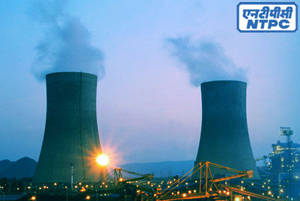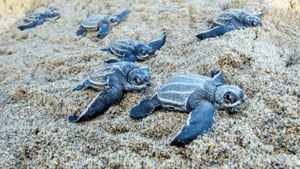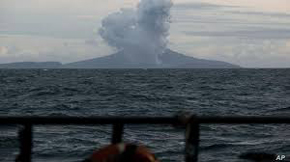April 2020 Environment
Sakshi Education
- NTPC launched Hydrogen Fuel bus and car project for Leh, New Delhi
 India's largest power producer, NTPC Ltd, has invited Global Expression of Interest (EoI) to provide 10 Hydrogen Fuel Cell (FC) based electric buses and an equal number of Hydrogen Fuel Cell-based electric cars in Leh and Delhi.
India's largest power producer, NTPC Ltd, has invited Global Expression of Interest (EoI) to provide 10 Hydrogen Fuel Cell (FC) based electric buses and an equal number of Hydrogen Fuel Cell-based electric cars in Leh and Delhi.
Highlights:
The first of its kind move aims to procure Hydrogen Fuel Cell-based vehicles is a project in the country. It will provide complete solutions from green energy to the fuel cell vehicle.
The EoI has been issued by NTPC's wholly-owned subsidiary, NTPC Vidyut Vyapar Nigam (NVVN) Limited.
The initiative is undertaken with support from the Ministry of New and Renewable Energy.
It will support renewable energy for the generation of hydrogen and develop the storage and dispensation facilities under the pilot projects at Leh and Delhi.
The move aims to launch hydrogen-powered vehicles at the decarbonizing mobility segment.
The company took various technology initiatives and will provide a complete e-Mobility solution for public transport including the creation of public charging infrastructure and providing electric buses to State/City Transport Undertakings.
Around 90 public charging stations in various cities and battery charging and swapping stations at Faridabad for e-3-wheelers have already been commissioned.
Also, the e-Bus solution for Andaman & Nicobar Administration is under implementation.
- Largest hole in ozone layer is closed now
Scientists from Copernicus European Centre for Medium-Range Weather Forecasts (ECMWF) reported that the largest hole in the Ozone layer spreading over 1 million square kilometers above the Arctic has closed due to unusual atmospheric conditions.
Ozone hole:
The hole in Ozone was first identified by scientists in March 2020. The development of the hole was confirmed by Copernicus Climate Change Service (C3S) and Copernicus Atmospheric Monitoring Services (CAMS) by the European Centre for Medium-Range Weather Forecasts (ECMWF).
Such holes in the ozone layer are quite common above the Antarctic at the South Pole especially during July to September but the ozone layer hole above the Arctic at this time was unusual.
The scientist stated that the closing of the hole has nothing to do too with the reduction in levels of pollution amid lockdown. But it is because of the polar vortex, high-altitude currents that are responsible for bringing cold air to polar regions.
Copernicus Climate Change Service:
C3S (Copernicus Climate Change Service) is the European Union's climate monitoring service. C3S are vital to study and monitor climate change adaptation. It provides climate and climate change information and knowledge by means of accessible, timely, reliable, and user-oriented products.
Note: Copernicus is the EU's Earth Observation Programme. It consists of a complex set of systems that collect data from multiple sources. The collected information will be processed and provides users with information through a set of services that address the atmosphere, climate change, land, marine, emergency management, and security.
Note: The ozone layer works as a protective shield as it prevents Sun's ultraviolet rays from entering Earth. UV from the sun can cause skin cancer.
- WIHG scientists reveal 35,000-year history of river erosion in Ladakh Himalayas
Scientists from the Wadia Institute of Himalayan Geology (WIHG) studied rivers in Ladakh Himalaya. Their study found out the 35,000-year history of river erosion and identified hotspots of erosion and wide valleys that act as buffer zones.
Highlights:
The study showed the operation of rivers in drier Ladakh Himalaya in longer time scales and the response of Ladakh Himalaya to varying climates.
As per the study, Ladakh Himalaya forms a high altitude desert between Greater Himalayan ranges and Karakoram Ranges.
The scientists also got the idea of water and sediment routing, which is crucial as the country gears up its infrastructure and develops smart cities.
The scientists traced the rivers draining Himalaya and its foreland erode the most and identify the zones that receive these eroded sediments and fill up.
It was found that most sediments were derived from Higher Himalayan crystalline that lies in the headwater region of Zanskar. The dominant factors responsible for sediment erosion were deglaciation and Indian Summer Monsoon derived precipitation in the headwaters despite the presence of a geomorphic barrier between the upper and lower catchments of the river, and it remained connected throughout its aggradation history.
This study will help to understand river-borne erosion and sedimentation, which are the main drivers that make large riverine plains, terraces, and deltas that eventually become the cradle to evolving civilizations.
Wadia Institute of Himalayan Geology (WIHG):
WIHG is a research institute for the study of Geology of the Himalaya under the Department of Science and Technology, Ministry of Science & Technology, GoI. It was established in 1968. It is located in Dehradun, Uttarakhand, India.
It provides consultancy and advisory services to various organizations for geotechnical feasibility of major and minor hydel projects, site selection for bridges and their foundation, slope stability, and control of landslides, site selection for deep tube wells, among others.
- Thailand beaches lure leatherback sea turtles to build most nests in 20 years
 The largest number of nests of rare leatherback sea turtles in Thailand beaches. The environmentalists said that this has occurred due to the bereft of tourists because of the coronavirus pandemic.
The largest number of nests of rare leatherback sea turtles in Thailand beaches. The environmentalists said that this has occurred due to the bereft of tourists because of the coronavirus pandemic.
Highlights:
The highest recorded turtle nests the authorities have found since last November was 11 in the past two decades.
Phuket Marine Biological Center reported that more number of turtle nests were found this year.
The turtles had a high risk of getting killed by fishing gear and humans disturbing the beach.
Leatherback Sea Turtles:
Leatherbacks are the world's most giant sea turtles. The turtles lay their eggs in dark and quiet areas, scarce when tourists thronged the beaches.
The International Union for Conservation of Nature (IUCN) has considered the species endangered in Thailand and listed as a vulnerable species globally.
- Indian herpetologists discover new viper species in Arunachal Pradesh
Indian herpetologists have discovered a new species of viper family in Pakke Tiger Reserve in Arunachal Pradesh, and the green pit viper species was discovered by a team led by Zeeshan Mirza.
The viper called Trimeresurus Salazar. It has a unique orange to reddish stripe present on the head and body in males.
The pit vipers belong to the genus Trimeresurus and are distributed widely across East and South-East Asia. This is the second species discovered within the course of the expedition to Arunachal Pradesh, which reflects the poor nature of biodiversity documentation across North-East India.
Dedicated surveys in the future conducted across north-eastern India will help document biodiversity, which is under threat from numerous development activities that include road widening, agriculture, and hydro-electric projects.
- Rare turtle nests spotted in Thailand
A large number of nests of rare leatherback sea turtles were spotted in the now-empty beaches of Thailand amid the novel coronavirus pandemic.
The number is the highest in two decades.
Leatherbacks, world's largest sea turtles, are considered endangered in Thailand.
The International Union for Conservation of Nature has listed leatherbacks as vulnerablespecies all across the world.
- NASA reported significant 20-years-low air pollution in Indo-Gangetic Plain amid lockdown
According to the satellite data published by US space agency National Aeronautics and Space Administration (NASA) stated that the air pollution over northern India has dropped to a 20-year-low for this time of the year.
The data were retrieved by the Moderate Resolution Imaging Spectroradiometer (MODIS) on NASA's Terra satellite.
Report Highlights:
The report highlighted that the sensors observed aerosol levels low after the imposition of a nationwide lockdown in India.
As per the analysis, an optical depth or thickness of less than 0.1 over the entire atmospheric vertical column shows a "clean" condition. If aerosols are concentrated near the surface, an optical depth of 1 or above indicates very "hazy" conditions.
The report tracked the aerosol optical depth (AOD). AOD shows how light is absorbed or reflected by airborne particles as it travels through the atmosphere.
Note: Aerosols are very tiny solid and liquid particles suspended in the air. It reduces visibility and can damage the human lungs and heart.
- NIF developed ten varieties of Anthurium
National Innovation Foundation-India (NIF) developed ten varieties of Anthurium, a flower with high market value, by cross-pollination. It was developed by D Vasini Bai, a women innovator from Thiruvananthapuram, Kerala.
She had developed large and medium-size flowers with uncommon color combinations of spathe and spadix. The institution has developed a new method for raising the seedlings in limited space using corrugated asbestos sheets.
Salient features of the Anthurium varieties are: they are large beautiful flowers with different colors of spathe and spadix and long stalks. The plant has a better shelf life and good market value.
Anthurium:
Anthurium (Anthurium spp.) is a vast group of blooming plants that is available in a wide range of colors. The plants of the varieties have high demands due to its use as an indoor decorative plant. The plant removes harmful airborne chemicals like formaldehyde, ammonia, toluene, xylene, and allergens. NASA has placed it in the list of air purifier plants because of its nature.
In 2019, over 8500 plants and the flowers were sold to the market of mainly Pune and Thiruvananthapuram. The innovator has been propagating it through cuttings & seeds and supplying some plants and flowers throughout the country, but she was unable to meet the demand due to the time-consuming technique of propagation method.
- Indonesian Anak Krakatau volcano witnessed longest eruption
 Indonesia's Anak Krakatau volcano erupted on 11th April. It spewed a column of ash 500 meters into the sky. It last erupted in 2018. No casualties were reported
Indonesia's Anak Krakatau volcano erupted on 11th April. It spewed a column of ash 500 meters into the sky. It last erupted in 2018. No casualties were reported
Anak Krakatau:
Anak Krakatau means the child of Kratakau, is the offspring of the famous Krakatau volcano. The volcano first erupted in 1883 triggered a period of global cooling. The island is located in a caldera in the Sunda Strait between the islands of Java and Sumatra in the Indonesian province of Lampung. The island is one of several in the area which is of considerable interest to volcanologists and the subject of extensive study.
Published date : 13 May 2020 11:29PM



















